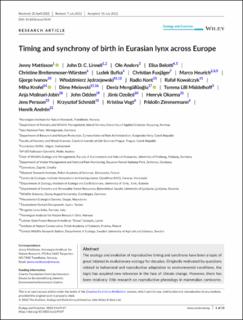Timing and synchrony of birth in Eurasian lynx across Europe
Mattisson, Jenny; Linnell, John Durrus; Anders, Ole; Belotti, Elisa; Breitenmoser-Würsten, Christine; Bufka, Ludek; Fuxjäger, Christian; Heurich, Marco Dietmar; Ivanov, Gjorge; Jędrzejewski, Włodzimierz; Kont, Radio; Kowalczyk, Rafał; Krofel, Miha; Melovski, Dime; Mengüllüoğlu, Deniz; Middelhoff, Tomma Lilli; Molinari-Jobin, Anja; Odden, John; Ozoliņš, Jānis; Okarma, Henryk; Persson, Jens; Schmidt, Krzysztof; Vogt, Kristina; Zimmermann, Fridolin; Andrén, Henrik
Peer reviewed, Journal article
Published version
Permanent lenke
https://hdl.handle.net/11250/3011796Utgivelsesdato
2022Metadata
Vis full innførselSamlinger
Originalversjon
10.1002/ece3.9147Sammendrag
The Eurasian lynx (Lynx lynx) occurs across the Eurasian continent, covering three of the four main climate regions of the world. Thus, their distribution includes a large variation in climatic conditions, making it an ideal species to explore reproductive phenology. Here, we used data on multiple reproductive events from 169 lynx females across Europe. Mean birth date was May 28 (April 23 to July 1), but was ~10 days later in northern Europe than in central and southern Europe. Birth dates were relatively synchronized across Europe, but more so in the north than in the south. Timing of birth was delayed by colder May temperatures. Severe and cold weather may affect neonatal survival via hypothermia and avoiding inclement weather early in the season may select against early births, especially at northern latitudes. Overall, only about half of the kittens born survived until onset of winter but whether kittens were born relatively late or early did not affect kitten survival. Lynx are strict seasonal breeders but still show a degree of flexibility to adapt the timing of birth to surrounding environmental conditions. We argue that lynx give birth later when exposed to colder spring temperatures and have more synchronized births when the window of favorable conditions for raising kittens is shorter. This suggests that lynx are well adapted to different environmental conditions, from dry and warm climates to alpine, boreal, and arctic climates. This variation in reproductive timing will be favorable in times of climate change, as organisms with high plasticity are more likely to adjust to new environmental conditions.

